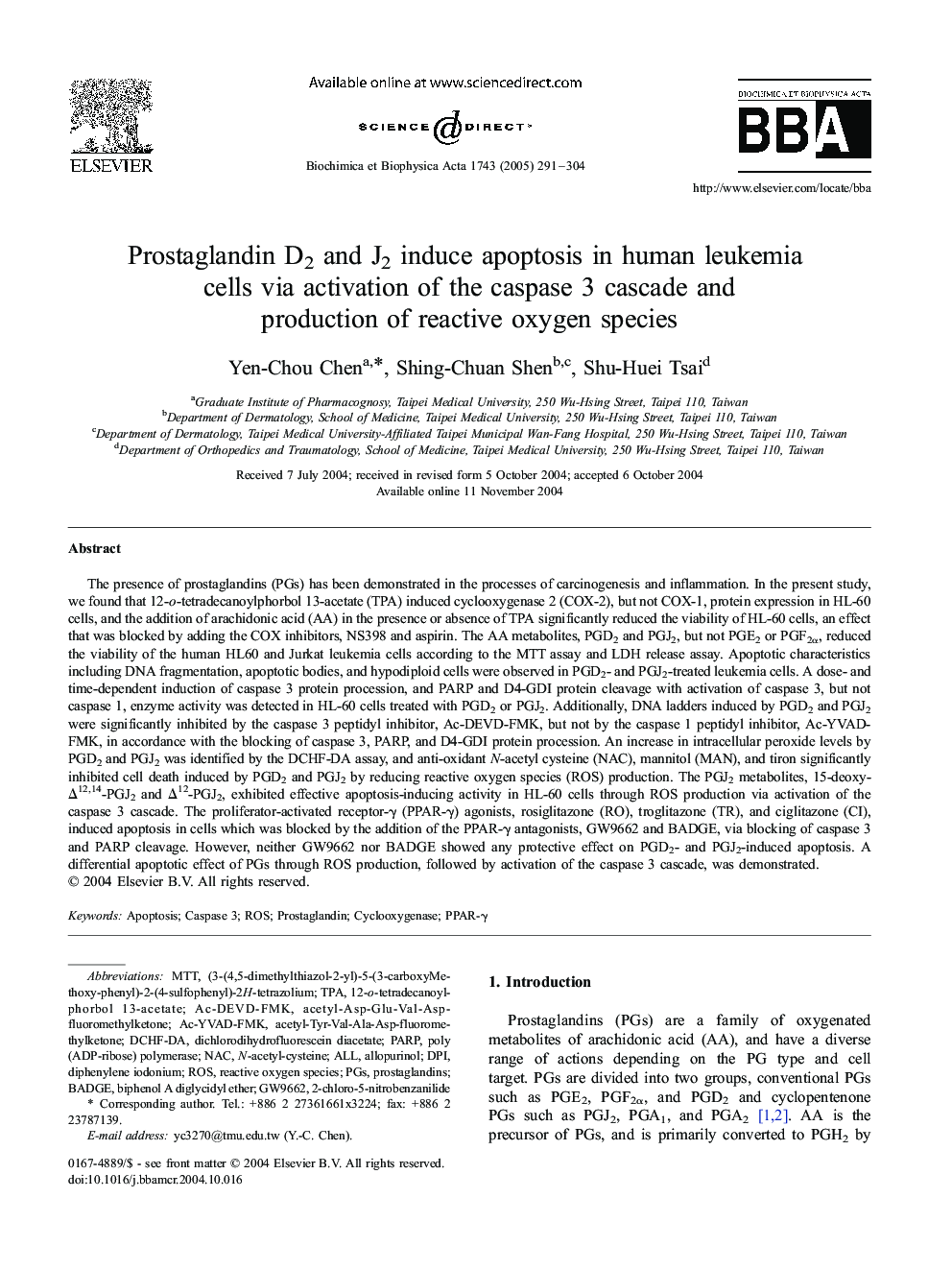| کد مقاله | کد نشریه | سال انتشار | مقاله انگلیسی | نسخه تمام متن |
|---|---|---|---|---|
| 10803223 | 1055805 | 2005 | 14 صفحه PDF | دانلود رایگان |
عنوان انگلیسی مقاله ISI
Prostaglandin D2 and J2 induce apoptosis in human leukemia cells via activation of the caspase 3 cascade and production of reactive oxygen species
دانلود مقاله + سفارش ترجمه
دانلود مقاله ISI انگلیسی
رایگان برای ایرانیان
کلمات کلیدی
DCHF-DAGW966212-O-tetradecanoylphorbol 13-acetatePGSPARPDPINACtPAPPAR-γMTT - MTTN-acetyl-cysteine - N-استیل سیستئینROS - ROSallopurinol - آلوپورینولcyclooxygenase - آنزیم سیکلواکسیژنازBADGE - بدApoptosis - خزان یاختهایdichlorodihydrofluorescein diacetate - دی کلستیدوفروفوروزین دی سکتهdiphenylene iodonium - دیوفنیلن یدونیومALL - همهProstaglandins - پروستاگلاندین هاprostaglandin - پروستاگلاندینهاPoly(ADP-ribose) polymerase - پلیمر (ADP-ribose) پلیمرازcaspase 3 - کاسپاز 3Reactive oxygen species - گونههای فعال اکسیژن
موضوعات مرتبط
علوم زیستی و بیوفناوری
بیوشیمی، ژنتیک و زیست شناسی مولکولی
زیست شیمی
پیش نمایش صفحه اول مقاله

چکیده انگلیسی
The presence of prostaglandins (PGs) has been demonstrated in the processes of carcinogenesis and inflammation. In the present study, we found that 12-o-tetradecanoylphorbol 13-acetate (TPA) induced cyclooxygenase 2 (COX-2), but not COX-1, protein expression in HL-60 cells, and the addition of arachidonic acid (AA) in the presence or absence of TPA significantly reduced the viability of HL-60 cells, an effect that was blocked by adding the COX inhibitors, NS398 and aspirin. The AA metabolites, PGD2 and PGJ2, but not PGE2 or PGF2α, reduced the viability of the human HL60 and Jurkat leukemia cells according to the MTT assay and LDH release assay. Apoptotic characteristics including DNA fragmentation, apoptotic bodies, and hypodiploid cells were observed in PGD2- and PGJ2-treated leukemia cells. A dose- and time-dependent induction of caspase 3 protein procession, and PARP and D4-GDI protein cleavage with activation of caspase 3, but not caspase 1, enzyme activity was detected in HL-60 cells treated with PGD2 or PGJ2. Additionally, DNA ladders induced by PGD2 and PGJ2 were significantly inhibited by the caspase 3 peptidyl inhibitor, Ac-DEVD-FMK, but not by the caspase 1 peptidyl inhibitor, Ac-YVAD-FMK, in accordance with the blocking of caspase 3, PARP, and D4-GDI protein procession. An increase in intracellular peroxide levels by PGD2 and PGJ2 was identified by the DCHF-DA assay, and anti-oxidant N-acetyl cysteine (NAC), mannitol (MAN), and tiron significantly inhibited cell death induced by PGD2 and PGJ2 by reducing reactive oxygen species (ROS) production. The PGJ2 metabolites, 15-deoxy-Î12,14-PGJ2 and Î12-PGJ2, exhibited effective apoptosis-inducing activity in HL-60 cells through ROS production via activation of the caspase 3 cascade. The proliferator-activated receptor-γ (PPAR-γ) agonists, rosiglitazone (RO), troglitazone (TR), and ciglitazone (CI), induced apoptosis in cells which was blocked by the addition of the PPAR-γ antagonists, GW9662 and BADGE, via blocking of caspase 3 and PARP cleavage. However, neither GW9662 nor BADGE showed any protective effect on PGD2- and PGJ2-induced apoptosis. A differential apoptotic effect of PGs through ROS production, followed by activation of the caspase 3 cascade, was demonstrated.
ناشر
Database: Elsevier - ScienceDirect (ساینس دایرکت)
Journal: Biochimica et Biophysica Acta (BBA) - Molecular Cell Research - Volume 1743, Issue 3, 15 April 2005, Pages 291-304
Journal: Biochimica et Biophysica Acta (BBA) - Molecular Cell Research - Volume 1743, Issue 3, 15 April 2005, Pages 291-304
نویسندگان
Yen-Chou Chen, Shing-Chuan Shen, Shu-Huei Tsai,